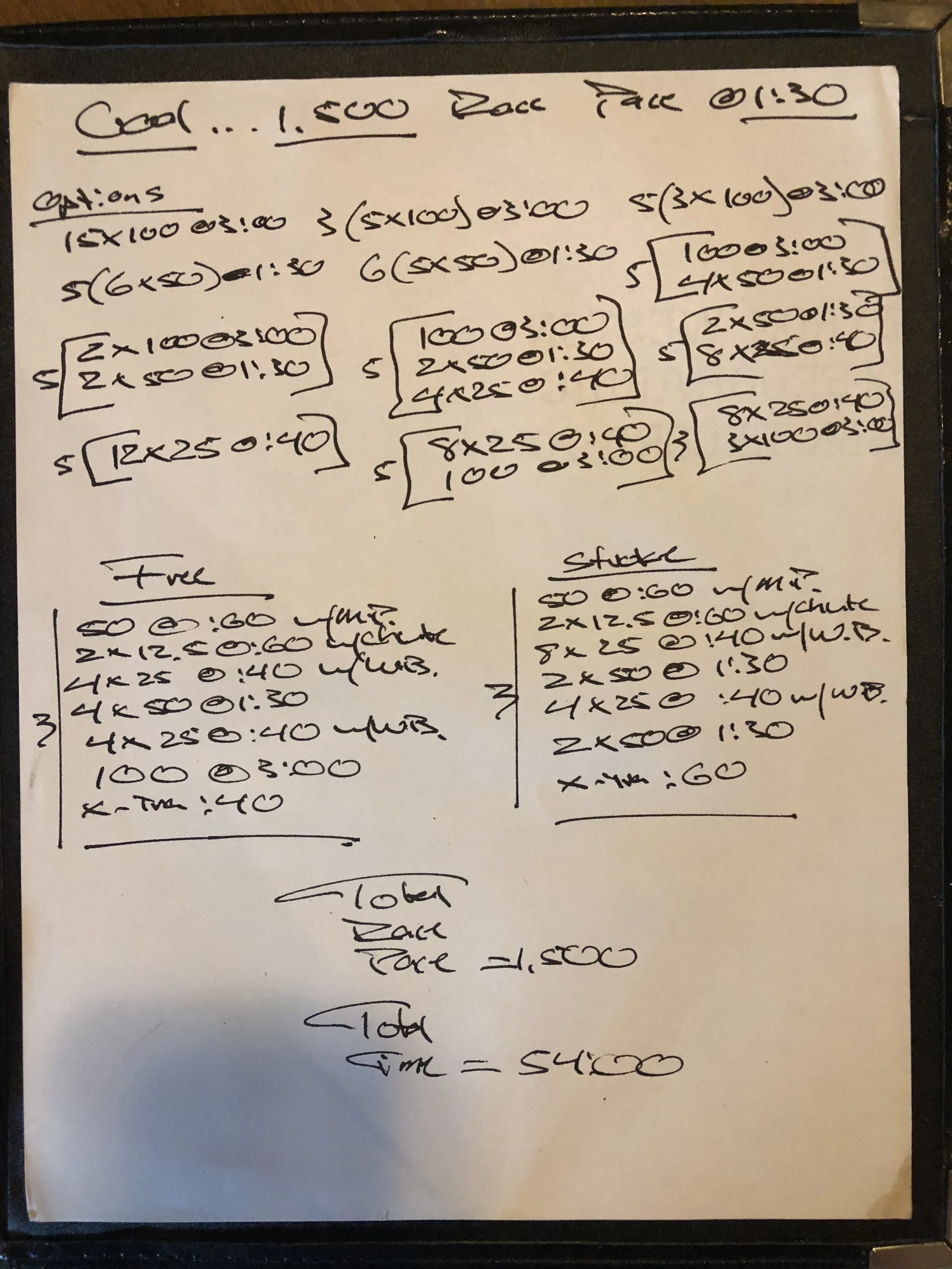3 Fast and Simple Ways to Increase Productivity
Are you competitive? Are you looking for an edge? Perhaps looking to make a more significant impact on the lives of those around you? Do you lead a company, organization, or athletic team? Maybe you want to stay on top of your schoolwork and decrease stress levels along the way? Whatever your stage in life, if you have a growth mindset and value personal development, increasing your productivity is no doubt high on your self-improvement list.
And of increasing productivity, to what exactly do I speak? I believe “personal productivity” is best defined in two parts - the quality and the quantity of our results. We can do more, increasing our overall output, and we can produce higher quality work. We can and should look to combine the two. Efficiency plays a role as well; for the sake of this article, I won’t explore it further as the goal is not to dwell on definitions of personal productivity, more to improve said productivity and our overall results. Whatever your desires regarding work and life outcomes, the following three simple strategies will help you achieve your desired results.
1. Say no. Do less to do more.
Well, of course. To recommend saying no more often may seem as though I am taking the easy way out, but these are the fast and simple ways to increase productivity after all, not the slow and complicated. Say no more often, and assuming you already work diligently and do not procrastinate, watch your productivity skyrocket. In this strategy you apply your current levels of energy, motivation, and cognitive horsepower to a smaller number of projects.
Saying no more often works well for increasing both your overall volume of output and the quality of your work. Deep Work by Cal Newport and The One Thing by Jay Papasan and Gary Keller are must-reads if you need more motivation to say no more often. While the idea is simple, I agree with you, saying no is of course much harder in the real world of work and life.
But it is worth it. Imagine if you applied the same amount of energy into fewer projects. Would you accomplish more with those specific projects? Would the quality improve? What of impact? I am sure your impact would increase, yes. To what degree you impact the world is limited only by your skill set and work ethic after you say no to energy sucks and low-value projects.
Of note, this strategy won’t increase the variety of your output. By definition and design, you are limiting your scope. But one should not take this advice to the extreme, and I do not recommend limiting yourself to one area of expertise. As this is the anti-niche blog, I do advise that we be well-rounded, motivated by the romantic ideal of the early enlightenment Polymath as our guide. I believe there is extreme value in a variety of cognitive stimuli, both in terms of input and output.
What we should limit are the time wasters and low-value projects. We should restrict consumption and creation that does not provide a high-value return. Say no. Do Less to do more. Saying no is one of the fastest ways to increase the quality and quantity of your productivity. Apply your energy and cognitive physiology to fewer options. Limit the chaos. Do less, but do more. This is not an original idea of mine. See Essentialism by Greg McKeown as a compliment to the aforementioned Deep Work and The One Thing. Together these three masterpieces in the personal development sphere will motivate you to do more by narrowing your field of view, eliminating the non-essentials, and going deep into your chosen field.
Take small steps to start - the more you say no to projects and time wasters that don’t move you towards your most significant goals, the easier saying no becomes. Perhaps the biggest challenge in saying no more often is the fear of what others will undoubtedly think. Be sure to explain the why behind your decision to do less, and be sure to deliver on those goals. In many cases you will need to justify saying no with sheer excellence in your few chosen endeavors - do not disappoint!
2. Maximize the Four Pillars of Elite Human Performance
I often write of what I believe are the Four Pillars of Elite Human Performance, and for a good reason. Can we determine a better way to improve our performance, across all disciplines, in both the physical and cognitive spheres? Deliberate practice of course, but consider these Four Pillars the foundation from which we practice, learn, etc.. It is hard to increase or maximize personal productivity in life without attacking the challenge from a base of human physiological and psychological excellence.
The Four:
Sleep
Diet
Exercise
Stress management
Specifics aside, work to improve the above Four Pillars, and you will quickly and easily increase your productivity. The above is not my opinion, this is irrefutable science, and should you ignore the four, your results will suffer. It is incredible, for lack of a better term, just how much we gain or lose in the productivity sphere based on how well we sleep. The compound effect is incalculable.
Some will debate the above. Some will question the efficacy thereof. No. Just do it. Accept and do. I generally suggest that people question everything...debate everything...but red lines of san(d)ity must exist somewhere, and to argue that sleep plays a diminished role in cognitive performance (increasing productivity) is not sane.
Furthermore, be not fooled by those who use outliers to refute the guidelines above. Perhaps a separate article altogether; in short, banish the following line of thinking from your mind and debate fervently those why try to fool you with outlier explanations:
“Because XYZ doesn’t sleep well and performs at a high level, I don’t need to sleep well to perform at a high level.”
XYZ is an outlier. Outliers exist but do not prove the rule. They fail to win the debate. As I have a growth mindset, I appreciate how great XYZ performs without sleeping well...but I wonder how much better the results with a devotion to the Four Pillars?
3. Use 2Do
One must use tools or systems to maximize productivity. We cannot hold everything in the brain, and anyone who tries to tell you otherwise is missing out on increased efficiency, accuracy, output, creativity, etc.. There are multiple books outlining tools and systems in this space - See David Allen’s Getting Things Done as one of the more famous examples.
My goal in this section is not to convince you to adopt a system; if you’re reading this, you certainly have something in place. My goal is to point you towards 2Do for your digital productivity tool of choice.
You may prefer an all-digital system, all paper-based, or a combination of the two. I excel in the third category, using a mix of digital and paper-based tools to maximize my productivity. If you are all-digital or a combination of paper and digital, 2Do is the application for you.
I regularly test the most popular personal productivity products on the market, including all the big names featured in the App Store, and without fail, 2Do surpasses all. My goal is not to criticize those companies and thus will not mention the apps by name, but you know where to find them should you need to compare. 2Do is better, hands down, and no other productivity experts have put up a strong argument to convince me otherwise.
I have no affiliation with 2Do, no incentive to recommend the product, no skin in the game or horse in the race. I look objectively at the various applications, evaluating the ease of use, features, organization, flow, etc...and 2Do is the clear winner, every time.
2Do handles just about anything you can throw its way. On the surface, it is a basic project and list management application, modeled on David Allen’s Getting Things Done. As a to-do list organizer and checklist manager, it is simple, easy to use, and efficient. Dig a little deeper, and the application can be as complicated as you want to make it, able to handle large projects from start to finish and makes quick work of even the busiest of schedules.
Just a few of the plethora of features:
- Location-based reminders and notifications
- Start and due dates
- Lists, checklists, projects, tasks
- File attachments
- Syncs with email
- Syncs with calendars
- Syncs with Siri
- Syncs with Dropbox as the recommended backup option
- Syncs with a plethora of CalDAV options
- Syncs across devices, including a full-service Apple Watch App with a dictation capture feature for easy mind sweeps
- Integration with many popular email clients, including Airmail and Spark
- And much, much more
In just one example of how I use 2Do, I have a section entitled “Liberty” where I have several lists that help me stay organized in the day to day of Division I coaching. One list in the Liberty section is “Staff,” where I list our full-time coaches, support staff, volunteers, and managers. From these lists I can:
- Track requests I receive from individuals that I need to complete
- Track requests made by me to others
- Track requests received and made between individuals
- Do all of the above with links to emails, files, etc.
- Do all of the above with tags, location-based reminders, due dates, start dates, etc.
For example, I have a “waiting on” tag where I can keep track of requests I make regarding various projects. I’ve found over the years that I have to track said requests to ensure 100% completion. It is easy for items to fall through the cracks or get lost in an email somewhere; not so with 2Do!
And to make tracking those requests easier still, I can attach the email request to the task within the app, allowing for easy access and the ability to quickly resend if needed...
At last count, the “Staff” list numbers 16 different people. Imagine tracking requests made to 16 different people in your head, or even through email - a formidable task, indeed!
I encourage you to download 2Do today and start to explore. Read David Allen’s Getting Things Done for a complete overview of the system, then reread it. Once you get a handle on 2Do and its power, you will wonder how you ever worked without it. I digress - you can work without 2Do, and you can get by. But again the growth mindset - imagine what more you could do and how much better you could do it - that is where you want to live, and 2Do will help you get there.
I don’t need 2Do to operate...but I would be lying if I told you it didn’t help me tremendously and make me more productive and efficient.
Final Thoughts
We are all facing tremendous pressure to do more and do it better. I enjoy the challenge and find great joy in the pursuit of prolific output. I trust you enjoy the process as well. In said pursuit, there are myriad ways we can improve the quality and quantity of our work. The above tips will go far in helping you achieve your goals, and I encourage you to start today. Say no more often. See the Four Pillars of Elite Human Performance as a tool to improve your work. Download 2Do and begin with a simple reoccurring checklist. Enter a few projects. Add a few location-based reminders for the next time you’re at XYZ, and watch your productivity skyrocket and stress levels decrease.
Above all, always seek to improve!
In a related article, check out Four Strategies to Tackle the Flow of Endless Information. Enjoy!


